
Welcome to tulsasnakes.com! I am David, a snake enthusiast living in Tulsa, OK. Many people don't know that Tulsa is in fact full of snakes! You just need to know where to find them - they can often be shy and elusive. Some Oklahoma snake species are more common outside of the city limits, in different parts of Tulsa County OK, but many types of snakes are indeed common in the more urban parts of Tulsa. This guide is meant to help educate you about the beautiful snakes of Tulsa, and to help you identify the most common snakes of Tulsa, as well as the venomous snakes of Tulsa that you should learn to recognize and avoid. If you want more detail, click here for my complete list of ALL snake species in Tulsa. Remember the following:
- Most snakes of Tulsa are harmless and don't want to encounter you
- Venomous snakes exist but are uncommon in Tulsa, Oklahoma
- Snakes eat rats and mice and are a valuable part of the Oklahoma ecosystem
- Never kill a snake - if you leave a snake alone, it will leave you alone.
Common Snake Species in Tulsa
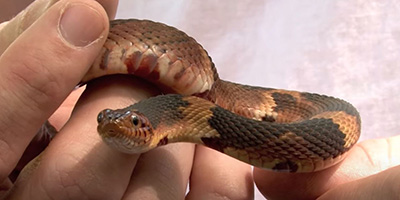 Broad-banded Water Snake:
Broad-banded water snakes typically have dark bands on the top of their bodies that are separated by 3-4 scales, which tend to be of a lighter color. The sides and bottom of its head are commonly yellow or are slightly white-colored. Their bellies are light-colored with belly markings that are somewhat rectangular shaped. The bellies are usually red, tan, or light brown in color. The rectangles on their bellies also sometimes come in different sets, they can come in twos, threes, and even fours. These snakes like to live near aquatic areas such as lakes and rivers in southeastern Oklahoma and can reach even the central-southern parts of the state.
Broad-banded Water Snake:
Broad-banded water snakes typically have dark bands on the top of their bodies that are separated by 3-4 scales, which tend to be of a lighter color. The sides and bottom of its head are commonly yellow or are slightly white-colored. Their bellies are light-colored with belly markings that are somewhat rectangular shaped. The bellies are usually red, tan, or light brown in color. The rectangles on their bellies also sometimes come in different sets, they can come in twos, threes, and even fours. These snakes like to live near aquatic areas such as lakes and rivers in southeastern Oklahoma and can reach even the central-southern parts of the state.
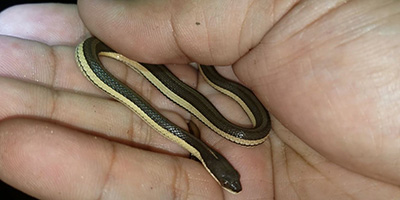 Graham’s Crayfish Snake:
These types of snakes are usually brown to gray in color. They also have cream-colored bellies. Their bellies and back are also separated by the three rows of scales that are a bit lighter than their scales on their backs. These snakes can be found around Central Oklahoma and in the Red River drainage. They like living in lakes, ponds, and any form of water that moves slowly and has a good population of crayfish. As their name suggests, these snakes love to feast on crayfish, their favorite meals are crayfish that have just recently molted. These snakes can also be found in urban areas. These snakes are small and can barely grow longer than 2 feet
Graham’s Crayfish Snake:
These types of snakes are usually brown to gray in color. They also have cream-colored bellies. Their bellies and back are also separated by the three rows of scales that are a bit lighter than their scales on their backs. These snakes can be found around Central Oklahoma and in the Red River drainage. They like living in lakes, ponds, and any form of water that moves slowly and has a good population of crayfish. As their name suggests, these snakes love to feast on crayfish, their favorite meals are crayfish that have just recently molted. These snakes can also be found in urban areas. These snakes are small and can barely grow longer than 2 feet
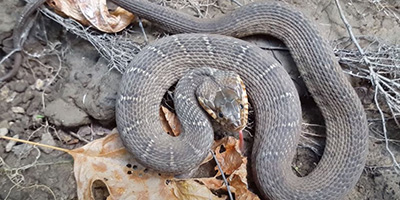 Plain-bellied Water Snake:
Plain-bellied water snakes are usually gray or olive in color. They also have blotches around their bodies that are typically lighter colored. In adults, however, the patterns can sometimes fade away to the point that they can no longer be distinguished. Their bellies are yellow and have no noteworthy markings. These snakes prey on both aquatic and land animals, when they perceive threats they usually resort to biting and releasing a foul smell. What makes this snake unique from other water snakes is that it is willing to leave the water if it means escaping prey or from capture. These snakes like to stay in areas that are near or above water, such as shrubs and tree branches. These snakes can be found in a plethora of places such as the southeastern parts of New Mexico and New Jersey and the northern parts of Michigan and Mexico.
Plain-bellied Water Snake:
Plain-bellied water snakes are usually gray or olive in color. They also have blotches around their bodies that are typically lighter colored. In adults, however, the patterns can sometimes fade away to the point that they can no longer be distinguished. Their bellies are yellow and have no noteworthy markings. These snakes prey on both aquatic and land animals, when they perceive threats they usually resort to biting and releasing a foul smell. What makes this snake unique from other water snakes is that it is willing to leave the water if it means escaping prey or from capture. These snakes like to stay in areas that are near or above water, such as shrubs and tree branches. These snakes can be found in a plethora of places such as the southeastern parts of New Mexico and New Jersey and the northern parts of Michigan and Mexico.
Venomous Snake Species in Tulsa
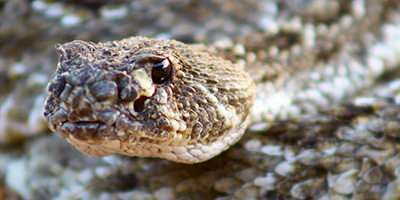 Western Diamondback Rattlesnake:
This type of diamondback rattlesnake is usually tan, brown, or grey in color. It also has a diamond-shaped pattern on its back and is commonly speckled with spots. These are also the most common rattlesnakes in the area. These snakes can be found in flat coastal areas but also can be located in high areas such as canyons and hillsides. They can also be found in deserts, grasslands, and pine-oak forests. These snakes can grow up to 4 feet.
Western Diamondback Rattlesnake:
This type of diamondback rattlesnake is usually tan, brown, or grey in color. It also has a diamond-shaped pattern on its back and is commonly speckled with spots. These are also the most common rattlesnakes in the area. These snakes can be found in flat coastal areas but also can be located in high areas such as canyons and hillsides. They can also be found in deserts, grasslands, and pine-oak forests. These snakes can grow up to 4 feet.
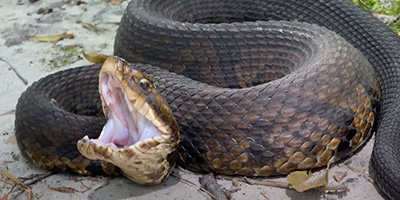 Cottonmouth:
The cottonmouth snake is typically black or dark brown in color. If it is all black it has no patterns on its skin, if it is dark brown it possesses a pattern of darker bands on its backs. Their bellies are also either black or dark brown in color. As young snakes, these snakes tend to have yellow tails. These snakes also have a very interesting diet, which consists of land mammals, birds, amphibians, other snakes, small turtles, and small alligators. Their name “cottonmouth” actually comes from the white lining you can see on their mouths, and when they are threatened they open their mouth wide and present their white lining. These snakes can grow up to 30-42 inches in length.
Cottonmouth:
The cottonmouth snake is typically black or dark brown in color. If it is all black it has no patterns on its skin, if it is dark brown it possesses a pattern of darker bands on its backs. Their bellies are also either black or dark brown in color. As young snakes, these snakes tend to have yellow tails. These snakes also have a very interesting diet, which consists of land mammals, birds, amphibians, other snakes, small turtles, and small alligators. Their name “cottonmouth” actually comes from the white lining you can see on their mouths, and when they are threatened they open their mouth wide and present their white lining. These snakes can grow up to 30-42 inches in length.
If you're unsure, you can email me a photo of the snake at info@tulsasnakes.com and I will email you back with the snake's species. If you found a snake skin, read my Found a Skin? page, and you can email me a photo of the skin, and I'll identify the snake for you. If you need professional Tulsa snake removal help, click my Get Help page, or see the below website sponsor I found, who provides that service.
Understanding The Black Rat Snake: Appearance, Biology, Life Cycle, Habitat, Diet, Behavior
The black rat snake is a common type of snake across the United States. If you live on the east coast or in the Midwest, you may have seen one at some point. While rat snakes are common across the world, this particular type resides in America. It lives throughout numerous states, becoming a widely known type to people. Most people know of them on some level or have seen them on their property. They are not dangerous and generally pose little risk to you or others. Even so, knowing more about them can help you keep safe and understand more about this particular snake. Understanding them is important for your safety and their own.
Appearance
As the name suggests, the black rat snake is a black snake. The top of its body is mostly black, with a white underbelly. It is the largest of the rat snakes, as well. It can get to up to 8 feet long, though they may be much smaller.
Life
Reproduction for the black rat snake is similar to that of most other snakes. It will seek out a mate during spring, mate, and lay eggs some weeks later. The eggs do not stay in the mother. The moment the snake is ready to lay eggs, she does. After a couple of months, the eggs hatch and the snakes are on their own. The mother is not going to care for them whatsoever.
Behavior
Black rat snakes are not going to go up to strangers. They would much rather stick to themselves and stay away from people. If people do go near them, they are likely to run away. If cornered or threatened, they may attack. Otherwise, they are unlikely to be a danger to anyone.
Habitat
Living in the eastern areas of the United States, black rat snakes typically reside where there are trees and rocks. Forested areas are their preference. They like to live in tree trunks, under rocks, and in other sheltered areas.
Diet
Black rat snakes have a typical diet, consisting mostly of rodents. They eat mice and rats alongside things like birds and eggs. For live food, they constrict the prey to kill it. They break it and kill it before consuming it. Black rat snakes are a common species of snake that most people can recognize. Though they can grow large, they are a mostly harmless snake that would rather be by its own and has no venom to harm others.
Remember, the term is not poisonous snakes of Tulsa, it's venomous snakes of Tulsa. Poison is generally something you eat, and venom is injected into you. That said, dangerous snakes are very rare in Tulsa. The few venomous snakes of Tulsa County are rarely seen. But they are commonly misidentified, so learn about all the snake species of Tulsa in order to correctly identify them. These snakes are usually also found in the surrounding towns of Jenks, Glenpool, Sperry, Turley, Lotsee, and the surrounding areas.
Read our article about:
Understanding The Coral Snake: Appearance, Biology, Life Cycle, Habitat, Diet, Behavior
tulsasnakes.com domain and hosting costs made possible by the generous support of this sponsor:
